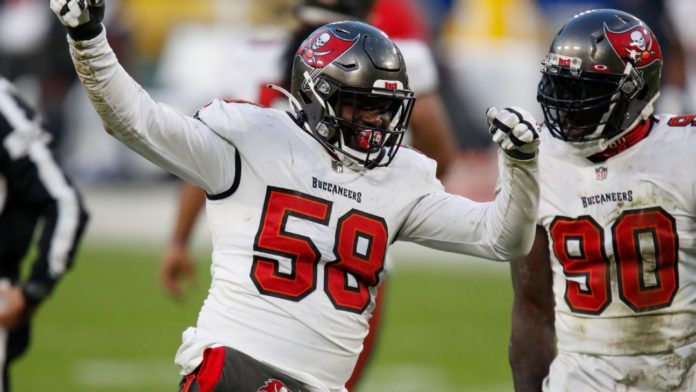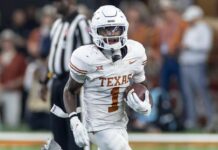TAMPA, Fla. — The Week 13 bye week that came on the heels of the Tampa Bay Buccaneers‘ 27-24 loss to the Kansas City Chiefs marked a turning point for their team, particularly on defense. The coaching staff spent a significant amount of time that week self-scouting to discern ways it could make things better, and it appears to have paid off.
While the incorporation of pre-snap motion and more play-action was noticeable on offense — resulting in more third-down conversions and scoring — the changes on defense were less noticeable, yet yielded substantial results. They’ve carried over into the postseason, particularly in the way the Bucs have gotten pressure on the quarterback. They sacked Aaron Rodgers five times and pressured him 22 times in their NFC Championship Game victory. They also forced four turnovers off New Orleans Saints QB Drew Brees in the NFC divisional game.
Here’s what they’re doing differently and how they might want to formulate a game plan going into Super Bowl Sunday.
Flip-flopping Shaq Barrett and Jason Pierre-Paul
One of the most noticeable changes defensive coordinator Todd Bowles made was moving outside linebackers Jason Pierre-Paul and Shaquil Barrett around more. In the first 12 weeks of the season, just 56 of Barrett’s 354 pass-rush plays (15.8%) came when rushing from the right side, against left tackles
Since the bye week in Week 13, however, Barrett has been rushing from the right side at nearly double the rate — on 27% of his snaps (50 of 133), whereas JPP was rushing from the right side on 69% of his snaps in Weeks 1-12. That number dropped to 55% in Weeks 14-16 (Barrett did not play in Week 17).
This was an important move, as 13 of Barrett’s NFL-leading 19.5 sacks in 2019 came rushing from the right side, going against left tackles. That doesn’t tell the whole story though. The usage of second-year backup Anthony Nelson has shot up. He’s playing nearly 10 more snaps per game since the bye week, and the rotation is keeping the other two fresher.
Playing tighter coverage, more 2-man
The Bucs’ secondary made changes during the bye week, too, which have allowed the defensive backs to play tighter coverage downfield.
Since the bye week, the Bucs are playing more 2-man coverage, using it 18.1% of the time vs. just 4.8% of the time in Weeks 1-12. They’ve also upped the rate of disguise in their coverages, so they’re continuing to dress things up so there’s less predictability.
The benefits of 2-man are that you can still play man defense aggressively with five underneath defenders — including being able to press, which the Bucs did a terrific job with against the Saints to disrupt the timing of their receivers — but have the benefit of safeties playing in two-deep zones up top. Traditionally, this type of coverage can make teams more vulnerable against the run because of where the safeties line up, but the Bucs have had the league’s No. 1 run defense all year, and they now have the benefit of a key cog up the middle with the return of 347-pound defensive tackle Vita Vea.
In terms of coverage, 2-man has been, by far, their best coverage this year. In 2-man, their rate of openness allowed — defined by NFL Next Gen Stats (NGS) as a throw where the degree of separation between the target and defender is 3-5 yards — is just 12.3%, versus a combined 23% in other overages (the lower the rate, the better). Opponents’ rate of wide openness (receivers who are open more than five yards) is 16.9% in 2-man, and all other coverages combined, it’s 24.2%.
The Bucs’ secondary has taken things up several notches in the postseason.
In Weeks 1-17, opposing quarterback’s passing attempts on tight window throws — defined by NGS as the rate in which a pass arrives and there is less than 1 yard between the target and the defender — was 12.3% during the regular season. In the postseason, it has been 19.7%. When the defender is closer to the ball at a higher rate, it indicates two things, which can be seen on tape: tighter coverage and a greater sense of anticipation as to where the ball is going.
Rate of openness is another way to look at the secondary to see if it’s in the right coverage. That number has gone from 22.9% to 18.1% from the regular season to the postseason, and it dropped to 15.7% in the divisional and league championship games. Again, this quantifies that Bucs defenders are where they’re supposed to be.
Putting it all together
Against the Chiefs in Week 12, the Bucs played a heavy dose of Cover 3 and Cover 2, with very little 2-man and far more man coverage. It was the wrong approach, as 2-man is actually the most effective coverage against quarterback Patrick Mahomes. He has just a 53.6% completion rate against it.
They’ll want to have a better matchup against Chiefs wide receiver Tyreek Hill than they had in the Week 12 loss. Carlton Davis simply didn’t have the speed (he’s longer and more physical, running a 4.44 at the NFL combine) to line up against Hill man-to-man with no safety help, and he got torched on two touchdowns as a result. They will have cornerback Jamel Dean back (he missed the game with a concussion) and he’s a much closer match, running a 4.30. Hill has also gotten really good at getting a release off the line of scrimmage, so it might not really matter whether they press him or not. And the problem is the Chiefs have more than one speedy wideout, whereas the Bucs have more cornerbacks like Davis — taller, longer and more physical. The Bucs could theoretically press Hill, and deploy Antoine Winfield Jr. over the top, but will Winfield be able to move as effectively with an ankle injury that forced him to miss the NFC title game?
Where the Bucs could really get some traction this go-around is up front. The Chiefs will be without left tackle Eric Fisher and are not expected to have Mitchell Schwartz on the right side. The offensive line combination they used in the AFC Championship Game was moving Mike Remmers to left tackle, with right guard Andrew Wylie moving over to the right tackle spot and backup Stefen Wisniewski moving into the right guard spot. The combination worked OK for the title game, with Wylie surrendering a sack.
Source : ESPN












